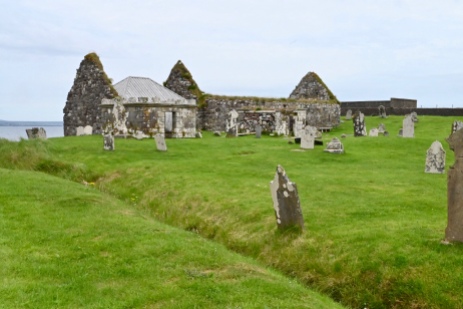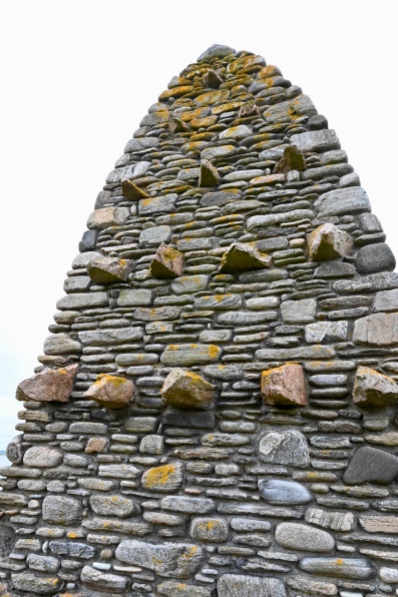Summer 2022: Stornoway

The second leg of our 2022 summer trip took us by ferry from Ullapool to Stornoway on the Isle of Lewis. On arrival, we did little more than have lunch and take a quick look at the harbour before heading for our holiday cottage on the other side of the island. We noticed the Stornoway Herring Girl and Sheòl an Iolaire / The Iolaire Sailed, the latter being new since I last visited.
On 1st January 1919, HMY Iolaire ran aground on rocks nearby. She was laden with naval reservists returning home from war and of 280 men on board only 79 survived. The Iolaire Sailed was installed at the centenary – it represents the exact shape and size of the ship with one post for each person on board, the white posts marking survivors. The installation appears and disappears with each tide and is lit at night to finally guide the ship home – a poignant thought.
One week later, we were back in Stornoway with more time to explore as we waited for our afternoon ferry. First we visited Eaglais na h-Aoidhe (the church on the isthmus), or St Columba’s, Ui, one of the best preserved pre-Reformation churches on Lewis. The earliest parts are thought to date to the 13th or 14th centuries.
Several important grave markers are kept undercover for preservation. Nineteen chiefs of the Clan Macleod are said to be buried here: the one with the effigy of a warrior is that of Roderick Macleod, 7th chief, who died in 1498.
And of course, graveyards in general always fascinate me. Here, they seemed to like essays on their memorials. They also seemed to breed saints. Witness the manly, frank, and generous Dr Angus Macleod who died at the young age of 28 in 1902.
And here is another doctor, Donald Macdonald, who died in 1907, and left to his family “the priceless inheritance of an honourable name, and to his widow her pride in sharing it”. I hope he also left some means of supporting them!
From the church we took a circular stroll along Broad Bay and back via the monument to the Aiginis farm raiders of 1888. During the Highland Clearances, crofting families were forcibly removed from land their ancestors had farmed for generations in favour of more profitable sheep and cattle farming. In January 1888 the men and women of Aiginis, facing starvation and poverty, rebelled and seized the farm. The government, rather than trying to understand their desperation, brought in the military to take it back. Thirteen men were imprisoned, but although the raid was unsuccessful in the short term it marked an important point in the struggle for land reform, and in 1905 the government caved in and divided Aiginis Farm into crofts. (Sadly, by this time many of the original raiders were dead).
As if this was not sad enough, we then drove to the spot where the Iolaire went down, Holm Rock, or the Beasts of Holm, where there are various monuments of different vintages. The markers in the water show just how close the ship was to the shore.
As you can see in the last image above, the Loch Seaforth was steadily approaching Stornoway, our signal to drive back to the ferry terminal to get into the queue for boarding. We arrived in Ullapool in the early evening, and stayed another night there before heading off for part 3 of our holiday – but that will have to wait until I’ve told you about our week on Lewis in between these two Stornoway visits.







































![Top-20-Travel-Blogs-200×150[1]](https://i0.wp.com/www.holiday365.co.uk/blog/wp-content/uploads/2012/06/Top-20-Travel-Blogs-200x1501.png)
Thank you for showing us Stornoway. Lewis and Harris are still up there on my places to visit list. Stornoway looks a fascinating place with many a story to tell. Look forward to hearing about the rest of the island.
LikeLike
I think you would love it there! Hugo would have a ball on all the beaches.
LikeLiked by 1 person
You are brilliant at including history in your posts, Anabel. In this case, a rather distressing history
LikeLike
Thanks Sue! The history is what fascinates me (and, yes, often distressing but important to remember).
LikeLiked by 1 person
Agreed, very important to remember
LikeLiked by 1 person
Hi Anabel – what an interesting area … and fascinating to be told about some of the important aspects – the crofters and the Iolaire shipwreck … so sad. Horrific what people were put through – so thank you for highlighting the Aiginis Farm raiders – I too would love to visit. Cheers Hilary
LikeLike
It certainly was horrific. So much hardship.
LikeLiked by 1 person
The Iolaire Sailed monument is so effective and moving, especially using the same number of posts as there were victims and survivors. I assumed she must have been lost well out to sea was astounded to find out at the end of your post how close she was to shore when she sank.
LikeLike
It really was a terrible – and avoidable – tragedy. The ship went just a little off course.
LikeLiked by 1 person
Mark made a moving Radio 4 programme about the Iolaire tragedy full of poetry and music, and it’s still available on BBC Sounds: https://www.bbc.co.uk/programmes/m0001tyz
LikeLike
Thanks for the tip! Good to see you this afternoon.
LikeLiked by 1 person
Seeing how close the Iolaire was to sure makes me incredulous about the number of lives lost. The weather must have been horrendous.
LikeLike
Indeed. And many couldn’t swim, plus they were weighed down by their uniforms. One man swam out from shore with a line and rescued a good half of the survivors. How brave!
LikeLiked by 1 person
That was a great read – thank you! Never knew of the Iolaire tragedy before – the memorials are so poignant.
LikeLike
Thanks Martin! It still casts its shadow on the island today.
LikeLike
Good to hear something about the history of the place as all my previous trips there involved bagging hills and not much else.
LikeLike
A lot more to it, Bob! We had some lovely walks not involving hills, mainly coastline.
LikeLike
A rather mournful visit but interesting.
LikeLike
Thanks. We tend to excel at finding the mournful …
LikeLiked by 1 person
Such an interesting article. I would like one day to visit that Island.
LikeLike
Thanks, Mélodie. All the Hebrides are lovely and well worth visiting.
LikeLiked by 1 person